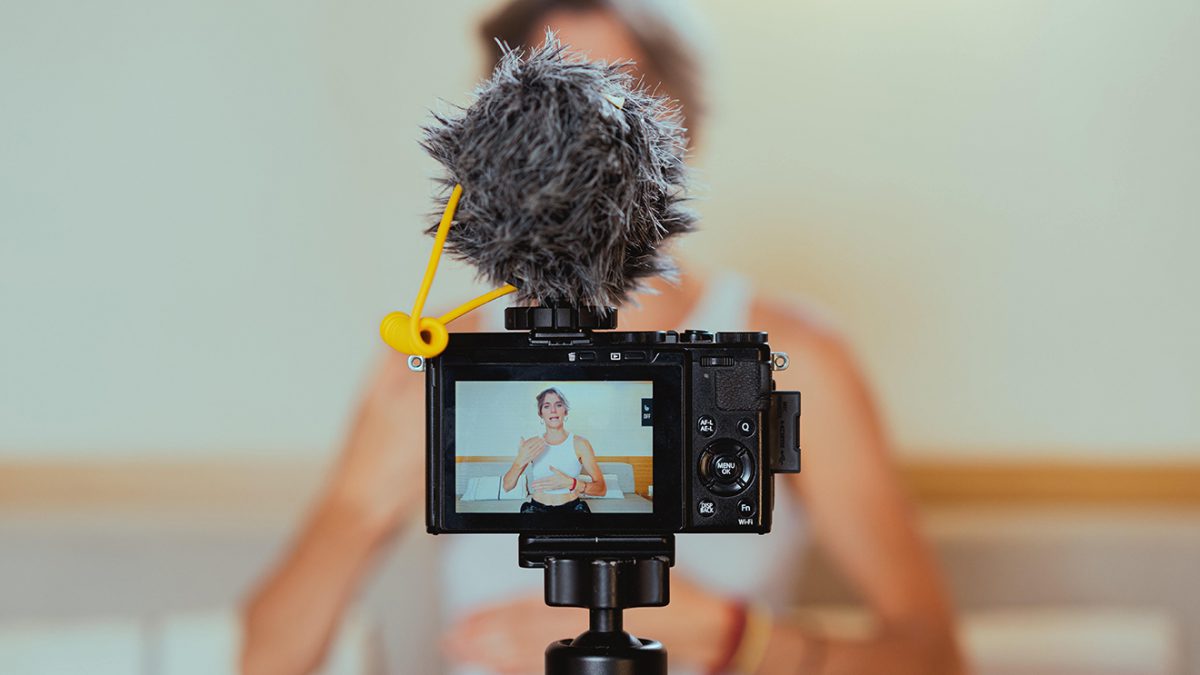While having a full-fledged video crew is great and has so many benefits, sometimes you’ll have to do video projects solo. This may seem like a daunting task, but with proper planning and some very helpful tools, you can become the one-person film crew of your dreams.
In this post, we’ll show you seven essential tools for solo film projects. They’ll not only make your life a lot easier, but they’ll also elevate the final cut.
Filming by yourself might be a creative choice or constraint. Either way, being able to control your gear from a distance, or even automatically, is of utmost importance. The recommendations below reflect that principle.
1. Choosing a Camera with the Right Features
The camera you choose is going to be a very important factor in the ease at which you can create a project on your own. Auto-focus and the ability to flip out the screen are going to make a big difference especially when you’re filming yourself.
Flip-Out Screen
If you’re shopping for a new camera, and you know you’ll be shooting a lot of videos solo, having a flip-out screen on your camera is going to be very beneficial. Being able to see yourself when you are framing your shot will speed up your process. You can also check your surroundings and yourself in real-time when the screen is facing you.
Additionally, having a moveable screen helps you behind the camera as well. Tilting the screen to counteract glare, using it to shoot high or low, or any situation where you can’t get your eye to the viewfinder.
Autofocus
Simply put, auto-focus allows the camera to pull focus automatically either through phase detection, contrast detection, or a combination of the two. While most if not all of newer cameras have autofocus systems built into them, it’s important to remember that not all are reliable and not all lenses support autofocus. Furthermore, camera systems with face detection, like Canons Cinema line, will provide even more with autofocus accuracy. Whether you’re shopping for a new camera or using what you already have, be sure to do plenty of research and tests to see what works best for you.
However, If you’re using a lens or camera without autofocus or a flip-out screen, there are other more advanced solutions you can turn to, which we’ll cover below.
2. External Monitor
What’s better than a flip-out screen when filming solo? A bigger separate screen you can use with your camera, also known as an external monitor. This larger screen will allow you to see your scene more clearly, identify any objects that are out of place when doing final checks, and give you a better idea of how your final footage will look.
In addition to those improvements, some external monitors have overlays for different compositions and potential crops. This comes in handy when you’re shooting for multiple platforms that need to be cropped in different ways. Lastly, external monitors typically have a much brighter screen than your camera screen, making outdoor filming a breeze.
3. Lens Control System
If you don’t have a camera with reliable autofocus, a lens without autofocus, or want to use a very specific type of lens, like an anamorphic lens, then a wireless lens control system might be for you. Wireless or remote focus systems allow you to pull focus from a distance. It pairs a control motor with a separate focus handwheel to free you from the camera.
These systems range in complexity and features as well. Some are simply a knob style handwheel, while more advanced systems come with accessories for attaching to gimbals, controlling zoom and focus with separate mechanisms, and lens mapping capabilities.
4. Camera Slider
No matter what type of video you’re creating, camera motion can add a whole new dimension to the story you’re telling. The question is, how can you add reliable camera movement when you’re shooting on your own? One answer is motorized camera sliders.
A camera slider is a set of tracks with brackets that mount to a tripod, light stand, or be used completely on its own. It allows you to get tracking or dolly shots that create a sense of movement as the attached camera moves along the tracks.
Things get really interesting when you get your hands on a motorized slider. These gadgets offer more control than the typical slider. You can program these sliders at different speeds, set automatic time-lapses, and of course, control it all remotely, which is going to be very useful when you’re filming on your own.
In addition to a normal slider, in recent years, motorized tripod heads have been making a name for themselves in the video world. These 4-axis motorized heads allow you to pan and tilt the camera smoothly with joy-sticks or through an app. Combined with a slider, you can create some really dynamic shots. Check out this video from DSLR Video Shooter on sliders and motion systems for more details on their benefits and how to use them.
5. Basic LED Light
When it comes to lighting, there are a lot of options out there that may work well for you. While daylight may be a natural collaborator for a lot of projects, it isn’t quite as reliable as you may want.
A remote-controlled LED light is an amazing option when working alone. Similar to many other options on this list, being able to make adjustments remotely is going to be immensely helpful and save time.
LED lights have a range of additional benefits as well. Compared to their incandescent or fluorescent counterparts, LEDs are more energy-efficient, longer-lasting, run at a cooler temperature, generally more durable, and some can emit a full range of colors.
6. Teleprompter
Memorizing a script is a skill that some can do with ease. For the rest of us, we would recommend investing in a good teleprompter. For those who don’t know, a teleprompter is a device that many video productions use as a way to have a heads-up display of your script right in front of the camera. You’ll need to pair your prompter with a teleprompter app on your tablet or smartphone to get this to work flawlessly.
We use one here at SproutVideo, and believe us when we say it does a phenomenal job to help deliver a message concisely. We use the One Take Only Pad Prompter and the PromptSmart Mobile app. For more on delivering your message flawlessly on camera read our full post on how to deliver your message.
7. 360 Camera
360 cameras were extremely trendy for a while but eventually lost their luster. Although many forgot about them, a 360 camera could be the perfect tool for your solo kit. They are made to capture literally everything around you and then let you create a video that stays close to the action.
They are really great for filming behind the scenes, tutorials, action, and so many other scenarios. You get to worry less about getting the shot because you know everything will be captured with a 360 camera. For a full rundown on 360 cameras, check out our How To Video episode featuring Tom Pagut, SproutVideo’s customer success lead, who has been using 360 cameras for years.
The right gear is a huge part of creating captivating stories through video. Whether you are on your own or working with a huge crew, the items listed above are sure to help you execute your creative vision. In the comments below, let us know how you’d use some of the items on this list to improve your video workflows.








